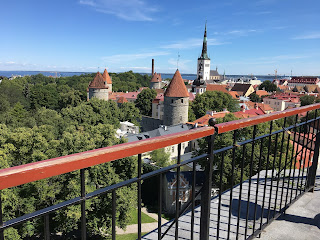 |
| View from the upper city overlooking the lower city |
We had a chance to visit Tallinn on our Estonian trip two weeks ago. As the capital of Estonia, it is one of the oldest and most preserved cities in Europe. Today the wall around the city has almost 30 of its towers still standing. When you visit Tallinn, you almost feel like you're stepping back into history since the wall was first erected in the 13th Century.
 |
| Government headquarters |
Tallinn is divided into two distinct areas, the upper city and the lower city. Historically, lower Tallinn was the site for merchants to live and work. Today it is the hub of tourism with shops and restaurants filling the cobbled streets.
 |
| Orthodox Church built during Russian rule |
The upper city is the site of the government buildings, the Orthodox Church and Lutheran Cathedral. Historically, the ruling class lived up here - the governor, archbishops and city councilors. During the night, the gates between the upper and lower areas were closed to prevent any lower class citizens from entering the upper area. However, more than once, a nobleman, who was out at a tavern too long, was locked out of the upper city and had to spend the night in the streets.
 |
| Stairway leading from lower city to upper |
 |
| Kiek in de Kok Tower |
 |
| Maiden Tower |
Today Tallinn isn't surrounded by the ancient wall, but many of the old sections are still maintained with access for tourists to walk on the top of the wall from one tower to the next. In the Medieval period, the covered walkway near the top of the wall had access to the outside wall for archers to slay the enemy during an attack.
 |
| Wall walkway |
 |
| Walking through the Bastion Passage |
We had the opportunity to explore the wall and even an underground tunnel built in 1710. The Bastion Passages were dug out as part of the fortification of the city. Today these tunnels are open as a museum to guests who can walk back in history to learn how these passages were used for many different scenarios.
During WWII, the bastion tunnels were used as a bomb shelter when the enemy was attacking the city. In the 70s to 80s, this was the air raid shelter in case of an atomic bomb. After freedom came in the 90s, this was the location for punk rockers to hang out and do drugs. Most recently, the homeless folks escaped there to have a roof over their heads until the museum took over the tunnels. It was certainly interesting to see how the passages were set up for all these episodes in time.
 |
| Section of the outer wall |
We only had a day to explore this amazing city. We could have spent several days to learn all there is about the history of Tallinn and Estonia. Put this on your bucket list for sure.












Comments
Post a Comment